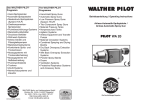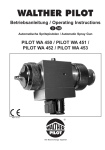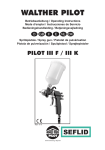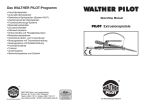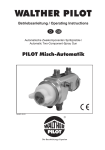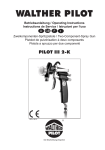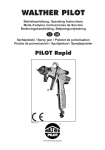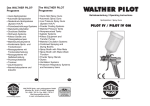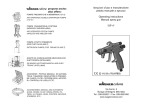Download WALTHER PILOT PILOT Misch-N Operating instructions
Transcript
Das WALTHER PILOTProgramm The WALTHER PILOT Programme • Hand-Spritzpistolen • Automatik-Spritzpistolen • Niederdruck-Spritzpistolen (System HVLP) • ZweikomponentenSpritzpistolen • Materialdruckbehälter • Drucklose Behälter • Rührwerk-Systeme • Airless-Geräte und Flüssigkeitspumpen • Materialumlaufsysteme • Kombinierte Spritz- und Trockenboxen • Absaugsysteme mit Trockenabscheidung • Absaugsysteme mit Nassabscheidung • Trockner • Zuluft-Systeme • Atemschutzsysteme und Zubehör • Hand-Held Spray Guns • Automatic Spray Guns • Low Pressure Spray Guns (System HVLP) • Two-Component Spray Guns WALTHER PILOT Betriebsanleitung / Operating Instructions Zweikomponenten-Spritzpistole Two-Component-Spray Gun • Material Pressure Tanks • Nonpressurized Tanks • Agitator Systems • Airless Equipment and Transfer Pumps • Material Circulation Systems • Combined Spraying and Drying Booths • Dry Back Overspray Extraction Systems • Wet Back Overspray Extraction Systems • Dryers • Ventilation Systems • Protective Respiratory Systems and Accessory Items PILOT Misch-N Typ / Type 24 320 REV. 03/10 WALTHER Spritz- und Lackiersysteme Kärntner Str. 18-30 42327 Wuppertal Germany Telefon: 0202 / 787-0 Telefax: 0202 / 787-217 www.walther-pilot.de • Email: [email protected] EG-Konformitätserklärung Declaration of CE-Conformity Wir, der Gerätehersteller, erklären in alleiniger Verantwortung, dass das Produkt in der untenstehenden Beschreibung den einschlägigen grundlegenden Sicherheits- und Gesundheitsanforderungen entspricht. Bei einer nicht mit uns abgestimmten Änderung an dem Gerät oder bei einer unsachgemäßen Verwendung verliert diese Erklärung ihre Gültigkeit. We, the manufacturers of the equipment, hereby declare under our sole responsibility that the product(s) described below conform to the essential safety requirements. This declaration will be rendered invalid if any changes are made to the equipment without prior consultation with us. Hersteller WALTHER Spritz- und Lackiersysteme GmbH Kärntner Str. 18 - 30 D - 42327 Wuppertal Tel.: +49(0)202 / 787 - 0 Fax: +49(0)202 / 787 - 217 www.walther-pilot.de • e-mail: [email protected] Typenbezeichnung Zwei-Komponenten Handspritzpistole PILOT Misch-N Verwendungszweck Type Designation Two-Component Manual spray Gun PILOT Misch-N Intended purpose Verarbeitung spritzbarer Materialien 24 320 Processing of sprayable media Applied Standards and Directives EU-Mechanical Engineering Directives 2006 / 42 / EC 94 / 9 EC (ATEX Directives) DIN EN ISO 12100-1 DIN EN ISO 12100-2 DIN EN 1953 EN 1127-1 DIN EN 13463-1 EG-Maschinenrichtlinien 2006 / 42 / EG 94 / 9 EG (ATEX Richtlinien) DIN EN ISO 12100 Teil 1 DIN EN ISO 12100 Teil 2 DIN EN 1953 DIN EN 1127-1 DIN EN 13463-1 Specification according 94 / 9 / EC Spezifikation im Sinne der Richtlinie 94 / 9 / EG Gerätebezeichnung WALTHER Spritz- und Lackiersysteme GmbH Kärntner Str. 18 - 30 D - 42327 Wuppertal Tel.: +49(0)202 / 787 - 0 Fax: +49(0)202 / 787 - 217 www.walther-pilot.de • e-mail: [email protected] 24 320 Angewandte Normen und Richtlinien Kategorie 2 Manufacturer II 2 G c T 6 Tech.File,Ref.: 2409 Bevollmächtigt mit der Zusammenstellung der technischen Unterlagen: Nico Kowalski, WALTHER Spritz- und Lackiersysteme GmbH, Kärntner Str. 18 - 30 D- 42327 Wuppertal Besondere Hinweise : Das Produkt ist zum Einbau in ein anderes Gerät bestimmt. Die Inbetriebnahme ist so lange untersagt, bis die Konformität des Endproduktes mit der Richtlinie 2006 / 42 / EG festgestellt ist. Wuppertal,den 07. Juli 2003 i.V. Name: Torsten Bröker Stellung im Betrieb: Leiter der Konstruktion und Entwicklung Diese Erklärung ist keine Zusicherung von Eigenschaften im Sinne der Produkthaftung. Die Sicherheitshinweise der Produktdokumentation sind zu beachten. Category 2 Part marking II 2 G c T 6 Tech.File,Ref.: 2409 Authorized with the compilation of the technical file: Nico Kowalski, WALTHER Spritz- und Lackiersysteme GmbH, Kärntner Str. 18 - 30 D- 42327 Wuppertal Special remarks : The named product is intended for installation in other equipment. Commissioning is prohibited until such time as the end product has been proved to conform to the provision of the Directives 2006 / 42 / EC. Wuppertal, the 7th of July 2003 i.V. Name: Torsten Bröker Position: Manager, Design and Development This Declaration does not give assurance of properties in the sense of product liability. The safety instructions provided in the product documentation must be observed at all times. Listing of Replacement Parts Item Contents Article No. Discription 1 2 3 4 V V V V 24 329 05 000 24 329 04 . . 0* 09 101 75 000 24 329 01 . . 3* Air cap nut Air cap Air cap seal Material nozzle 5 V 11 306 21 . . 3* Material needle 6 7 V 24 321 01 000 V 10 361 08 000 Gun body Needle packing V V V V V V V V V V V V V V V V V V V V V V V V V Needle gland nut Driving bushing Counter-screw Wide jet regulator Lever shank screw Distance bushing Lever screw Double nipple Cap nut Hose grommet Double nipple Cap nut Hose grommet Spring bushing Needle spring Counter-screw Valve housing Valve spring Valve cone Valve shaft Packing Valve compression gland Double nipple Seal Trigger 8 9 10 11 12 13 14 15 16 17 18 19 20 21 22 23 24 25 26 27 28 29 30 31 32 01 101 01 000 10 306 06 000 10 306 08 000 10 902 00 000 24 321 05 000 24 321 06 000 10 301 09 000 24 321 03 000 00 101 03 000 00 101 02 003 24 381 05 000 00 101 12 005 24 321 09 003 24 306 05 000 10 306 04 000 20 001 06 000 10 904 04 000 10 304 03 000 10 904 02 000 10 304 01 000 09 101 02 020 10 901 06 000 00 101 01 000 09 101 76 010 24 321 04 000 The wearing parts are shown in boldface print in the list of the replacement parts. We recommand that wearing parts are held on stock. Nozzle sets constist of air control head, material nozzle and material needle. Nozzle sets No.: V 15 019 02 . . 3 * Please quote the respective sizes when ordering replacements. (Nozzle sizes optional:0,5 • 0,8 • 1,0 • 1,2 • 1,5 • 1,8 • 2,0 • 2,5 mm ø) 1 General Information 1.1 1.2 1.3 Identification of Model Version Normal Use Improper Use 2 Technical Description 3 Safety Instructions 4 Connection of Input Lines 5 Operation 5.1 5.2 5.3 5.4 5.5 Safety Instructions Requirements at the Start and Finish of Operation Spray Pattern Test Spray Pattern Adjustment Retooling the Spray Gun / Repairs 6 Cleaning 6.1 6.2 6.3 Safety Warnings General Cleaning Procedure Routine Cleaning 7 Troubleshooting 8 Disposal of Cleaning and Servicing Substances 9 Specifications 1 1.1 General Information Identification of Model Version Model: Two-Component Spray Gun PILOT Misch-N Type: Pilot Misch-M Manufacturer: WALTHER Spritz- und Lackiersysteme GmbH Kärntner Straße 18-30 D-42327 Wuppertal Tel: +49 202 787-0 Fax:+49 202 787-217 www.walther-pilot.de • Email:[email protected] 1.2 24 320 Normal Use The hand-held spray gun PILOT Misch-N is a two-component manual spray gun for materials with a short pot life. The hand-held spray gun PILOT Misch-N is designed exclusively for use with sprayable media, including water-based and aggressive media, such as: • paints and laquers • greases, oils and corrosion preventives • ceramic glazes • pickling solutions Since all wetted parts are made of stainless steel, water-based media may be used as well. If you have any questions, please contact WALTHER Spritz- und Lackiersysteme GmbH, Wuppertal. Sprayable material should only be applied to work pieces or similar objects. The temperature of the material to be sprayed should at no time exceed 43° C. The term Normal Use also implies that any and all safety warnings and instructions laid down in these operating instructions have been read, understood and are duly complied with. This equipment complies with the explosion protection requirements of Directive 94/9/EC (ATEX) for the explosion group, equipment category and temperature class indicated on the type plate. When using the equipment, the requirements specified in these Operating Instructions must be observed at all times. The technical data indicated on the equipment rating plates and the specifications in the chapter "Technical Data" must be complied with at all times and must not be exceeded. An overloading of the equipment must be ruled out. 1 The equipment may be used in potentially explosive atmospheres only with the authorisation of the relevant supervisory authority. The relevant supervisory authority or the operator of the equipment are responsible for determining the explosion hazard (zone classification). The operator must check and ensure that all technical data and the marking of the equipment in accordance with ATEX are compliant with the necessary requirements. The operator must provide corresponding safety measures for all applications in which the breakdown of the equipment might lead to danger to persons. If any irregularities are observed while the equipment is in operation, the equipment must be put out of operation immediately and WALTHER Spritz-und Lackiersysteme must be consulted. Grounding / Equipotential Bonding Measures must be taken to ensure that the spray gun is sufficiently grounded (earthed) by means of a conductive air hose (maximum resistance 106 ). 1.3 Improper Use The spray gun must not be used for purposes other than those laid down in the above section 1.2 Normal Use. Any other form of use is prohibited. Improper use includes • the spraying of material on persons and animals • the use of liquid nitrogen. 2 Technical Description The model Pilot Misch-N feeds both material components to the separate connections. Mixing takes place only in the spray jet. The mixing ratio and the material flow rate are determined by the different nozzle sizes and the material pressure. When the trigger (item 32) is actuated, the valve cone (item 26) opens first of all (pre-air), after which the material supply is opened as the material needle (item 5) is pulled back. Closing takes place in the reverse order. The width of the spray jet can be infinitely varied by the wide jet regulator (item 11). 2 3 General Safety Instructions All applicable accident prevention rules and regulations as well as other recognised industrial safety and health rules and regulations must be observed at all times. Use the spray gun only in well-ventilated rooms. Fire, naked flames and smoking are strictly prohibited within the working area. WARNING – during the spraying of flammable materials (e.g. lacquers, adhesives, cleaning agents, etc.), there is an increased risk to health as well as an increased risk of explosion and fire. Measures must be taken to ensure that the spray gun is sufficiently grounded (earthed) by means of a conductive air hose (maximum resistance 106 ). Before carrying out maintenance or servicing work, always ensure that the air and material feed to the spray gun have been de-pressurised. Risk of injury! When spraying materials, do not place your hands or other parts of the body in front of the pressurised nozzle or the spray gun. Risk of injury! Never point the spray gun at persons or animals. Risk of injury! Always observe the spraying and safety instructions given by the manufacturers of the spraying material and the cleaning agent. Aggressive and corrosive materials in particular can be harmful to health. Exhaust air containing particles (overspray) must be kept away from the working area and personnel. In spite of these measures, always wear the regulation breathing masks and protective overalls when using the gun. Airborne particles represent a serious health hazard! Always wear hearing protection when using the gun or when in the vicinity of a gun that is in use. The noise level generated by the spray gun is approx. 85 dB (A). After carrying out assembly or maintenance work, always ensure that all nuts, bolts and screw connections have been fully tightened before the gun is used. Use only original replacement parts, since WALTHER can only guarantee safe and fault-free operation for original parts. For further information on the safe use of the spray gun and the spraying materials, please contact WALTHER Spritz- und Lackiersysteme GmbH, D-42327 Wuppertal, Germany. 4 Connection of Input Lines Note Please refer to the exploded view supplied with this manual when performing the installation steps described on the following pages. Warning The air pressure of the gun must not exceed 8 bar; otherwise safe operation of the gun cannot be guaranteed. Warning Material and air hoses which are installed with a hose grommet must be additionally secured with a hose clamp. 1. Connect the air hoses (cleaned compressed air) to the material pressure tanks and the air inlet (item 30)of the spray gun. 2. Fill the material pressure tanks for component A and component B with the respective material and close the lid. 3. Fasten the material inlet hose to its respective material pressure tank or the material pressure regulator, if a pump system is used, and to the material inlets (item 15 and 18) of the spray gun. 4. Switch on the pressurised air and adjust the air pressure reduction valve to the required atomizing air pressure. Adjust the air pressure reduction valves on the material pressure tanks to the required pressure. If the material is fed via a pump system the pressure is adjusted via an adjusting key on the material pressure control. 5. Open the material tap at the material outlet of the relevant pressure tank. Material connection (item 15)(R 1/4’’-1/4’’) 6. To bleed any air left left in the material hose actuate the trigger until a uniform jet emerges from the nozzle. The spray gun is now ready for operation. Material connection (item 18) (R 1/4’’-3/8’’) Air supply 3 4 5 5.1 Operation Safety Instructions Please pay special attention to the following safety instructions when using the spray gun! • Be sure to wear the required respiratory protection masks and protective overalls whenever you are operating the spray gun. Airborne particles represent a health hazard. • Be sure to wear suitable ear protection. The spray gun produces sound levels of approx. 83 dB (A). • No open fires, naked lights or smoking in the working area. The spraying of readily inflammable media is accompanied by an increased risk of fire and explosion. 5.2 Requirements at the Start and Finish of Operation The following requirements must be met before the spray gun is operated: • The atomizing air pressure must be available at the gun • The material pressure must be available at the gun. Caution The material pressure should not exceed 8 bar. The air pressure should not exceed 8 bar. Otherwise the operational reliability of the spray gun will be impaired. Warning It is important to remember to relieve the spray gun of all pressures when work is terminated. Lines left under pressure may burst and the released material may injure any persons in the vicinity. 5.3 Spray Pattern Test Spray pattern tests should be performed whenever: • the spray gun is taken into operation for the first time • the spraying medium has been changed • the spray gun was taken apart for maintenance or repair works. The spray pattern is best tested using a workpiece sample, a sheet of metal, cardboard or paper. Warning Keep your hands or other parts of the body away from the spray gun nozzle under pressure - risk of injury. Warning Make sure that no other people are in the spraying zone when the spray gun is started - risk of injury. 5 1. Start the gun to produce a spray pattern sample (see 5.2 Requirements at the Start and Finish of Operation). 2. Inspect the sample and, if necessary, adjust the settings of the gun (see 5.4 Spray Pattern Adjustment). 5.4 Spray Pattern Adjustment The spray pattern of the Pilot Misch-N can be adjusted as follows: Adjusting the Material Flow Rate The material flow rate is determined by the nozzle size and the material pressure. Adjusting the Material Pressure The material pressure can only be adjusted at the pump or the pressure tank. Please follow the instructions and safety instructions issued by the manufacturer. Adjusting the Flat-Jet The width of the spray jet can be infinitely varied by the wide jet regulator (item 11). 5.5 Retooling the Spray Gun / Repairs Air control head, material control nozzle and needle packing, all chosen for a particular spraying material, together form a unit - the nozzle insert assembly. Always change the complete insert assembly to maintain the desired spray finish quality. Warning Air and material inputs must be shut off prior to retooling - risk of injury. Note Please refer to the exploded view supplied with this manual when performing the installation steps described on the following pages. Replacement of Material Nozzle and Air Control Head 1. Unscrew the air cap nut (item 1). 2. Remove the air control head (item 2). 3. Remove the material control nozzle (item 4) from the gun body (item 6), using wrench (width over flats 12.) 4. Remove the air cap seal (item 3) from the material nozzle. Reassembly of the new nozzle insert and the remaining parts is performed in reverse order. When mounting observe that the hole of the air control head exact matches with the guide pin of the gun body. The nozzles are useable for different application. 6 Replacement of Material Control Needle 1. Unscrew the spring bushing (Item 21). 2. Remove the spring spring (Item 22). 3. Remove the material needle (Item 4) with the driving bushing (item 9) and the counter-screw (item 10) from the gun body. Remove the needle from the dring bushing. The distance between the tip of the material needle and the driving bushing should be 78 ± 0.5 mm. Control the distance and ensure with the counter-screw. Reassembly is performed in reverse order. Replacement of Valve Cone 1. Unscrew the valve housing (item 24) from the gun body. 2. Remove the valve spring (item 25) and the valve cone (item 26) from the gun body. Reassembly is performed in reverse order. Replacement of Defective Needle Seal Packings 1. Remove the material control needle as described in "Replacement of Material Control Needle “. 2. Unscrew the needle packing gland (item 8) from the gun body 3. Remove the needle seal packing (item 7) from the gun body. Use a strong wire with one end bent to form a small hook. Reassembly of replacement parts is performed in reverse order. Note Prior to assembly all moveable and sliding parts should be lubricated with a non-acidic, non-resinogenic grease. Note The wearing parts are shown in boldface print in the list of the replacement parts. 6 6.1 Cleaning Safety Warnings • Prior to any service work all air and material inputs should be shut off - risk of injury. • Open fires, naked lights and smoking are prohibited in the working area. There is an increased risk of fire and explosion, when spraying readily flammable media, such as cleaning solutions. • Follow the safety instructions issued by the manufacturer of the cleaning media. Aggressive and caustic cleaning agents in particular represent health hazards. 6.2 General Cleaning Procedure The spray gun should be frequently cleaned and lubricated to ensure reliable operation and long life. Caution Never immerse the spray gun in solvents or other cleaning fluids as this will impair the functional reliability and efficiency of the gun. Caution Do not use any hard or sharp-pointed objects when cleaning the spray gun, as the precision-made parts can easily be damaged and are likely to affect your spraying results. Only use cleaning solutions recommended by the manufacturer of the spraying material. These solutions should not contain any of the following constituents: • halogenated hydrocarbons (e.g. 1,1,1-trichloroethane, methylene chloride etc.) • acids and acidic cleaning solutions • regenerated solvents (so-called cleaning dilutions) • paint removers. These constituents cause chemical reactions with electroplated components resulting in corrosion damage. WALTHER Spritz-und Lackiersysteme is not liable for any damages resulting from improper treatment of the gun. The spray gun should be cleaned • prior to every change of the spraying medium • at least once a week • as often as necessary because of the spraying medium used and the resulting level of soiling. 7 8 Following these recommendations will ensure safe spray gun operation and performance. 1. Dismantle the gun as described in section 5.5 Retooling the Spray Gun. 2. Clean the air control head and nozzle with a brush dipped in the recommended cleaning solution. 3. Clean the gun body and all remaining parts with a soft cloth and the recommended cleaning solution. 4. Apply a thin layer of grease to the following parts: • material control needle • needle spring • all sliding parts and bearings. • The moveable inner parts should be greased at least once a week. • The springs should at all times be coated with a thin layer of grease. 7 Troubleshooting Warning Prior to any servicing and repair work the spray gun should be in unpressurised state, i.e. all control air and atomizing air pressure as well as all material inputs must be shut off - risk of injury. Fault Gun is dripping Routine Cleaning Material control needle or nozzle soiled Clean It is not always necessary to dismantle the spray gun for cleaning purposes when paint colour is changed at regular intervals or at the end of a work period (depending, of course, on the material used). Material leaks Needle gland nut is loosen Tighten behind the needle pakNeedle packing (item 7) defecti- Replace king ve For routine cleaning purposes please observe the following steps: Pulsating or unsteady spray jet 1. Fill the clean material pressure tanks with a cleaning solution compatible with the material used. 2. Start the spray gun (see 5.2 Requirements at the Start and Finish of Operation). 3. Do not stop the gun until only clear cleaning solution emerges from the nozzle. The complete spraying system should stay depressurised until the gun is used again. Level in material tank too low Top up material level (see Manufacturer`s Operating Instr.) Material soiled Replace the material filter (see Manufacturer`s Operating Instr.) Material control nozzle is loose or damaged Tighten or replace Air cap seal (item 3) is damaged Replace Gun keeps Valve spring (item 25) or valve Replace blowing in off- cone (Item 26) damaged position Packing (item 28) is screwed too Slightly unscrew tight Spray jet is one-side 9 Remedy Material control needle or nozzle damaged Replace; see 5.5 Retooling the Spray Gun Needle spring (item 22) defective Remove material needle and Spring bushing (item 21) is scre- replace spring wed back too fast Slightly unscrew Needle gland nut (item 8) turned too far Slightly unscrew Use non-acidic, non-resinogenic grease and a brush. The spray gun is then reassembled in reverse order. 6.3 Cause Air cap (item 2) soiled Clean Air cap nut (item 1) is loosen Tighten 10 8 Disposal of Cleaning and Servicing Substances The disposal of substances used for cleaning and servicing should be in accordance with local, national and international laws and directives. Warning Particular attention should be paid to the spray and cleaning media manufacturers' instructions. Improper disposal represents a serious threat to the health of humans and animals. 9 Specifications Net Weight: 930 g Air Control Head: External mixing air cap Nozzle sizes optional: 0.5 • 0.8 • 1.0 • 1.2 • 1.5 • 1.8 • 2.0 • 2.5 mm ø Pressure Ranges: Max. Atomizing Pressure Max. Material Pressure 8 bar 8 bar Max. Operating Temperature of Spray Gun 43 °C Noise Level (measured at a distance of ca. 1 m from spray gun) 83 dB (A) Air consumption in litres/min.: Input 1.0 2.0 3.0 4.0 5.0 6.0 bar bar bar bar bar bar Round fan Wide fan 230 290 340 390 430 470 280 390 450 510 550 600 Right to effect technical changes reserved. 11










